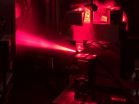(Press-News.org) STANFORD, Calif. — If you were a bacterium, the virus M13 might seem innocuous enough. It insinuates more than it invades, setting up shop like a freeloading houseguest, not a killer. Once inside it makes itself at home, eating your food, texting indiscriminately. Recently, however, bioengineers at Stanford University have given M13 a bit of a makeover.
The researchers, Monica Ortiz, a doctoral candidate in bioengineering, and Drew Endy, PhD, an assistant professor of bioengineering, have parasitized the parasite and harnessed M13's key attributes — its non-lethality and its ability to package and broadcast arbitrary DNA strands — to create what might be termed the biological Internet, or "Bi-Fi." Their findings were published online Sept. 7 in the Journal of Biological Engineering.
Using the virus, Ortiz and Endy have created a biological mechanism to send genetic messages from cell to cell. The system greatly increases the complexity and amount of data that can be communicated between cells and could lead to greater control of biological functions within cell communities. The advance could prove a boon to bioengineers looking to create complex, multicellular communities that work in concert to accomplish important biological functions.
Medium and message
M13 is a packager of genetic messages. It reproduces within its host, taking strands of DNA — strands that engineers can control — wrapping them up one by one and sending them out encapsulated within proteins produced by M13 that can infect other cells. Once inside the new hosts, they release the packaged DNA message.
The M13-based system is essentially a communication channel. It acts like a wireless Internet connection that enables cells to send or receive messages, but it does not care what secrets the transmitted messages contain.
"Effectively, we've separated the message from the channel. We can now send any DNA message we want to specific cells within a complex microbial community," said Ortiz, the first author of the study.
It is well-known that cells naturally use various mechanisms, including chemicals, to communicate, but such messaging can be extremely limited in both complexity and bandwidth. Simple chemical signals are typically both message and messenger — two functions that cannot be separated.
"If your network connection is based on sugar then your messages are limited to 'more sugar,' 'less sugar,' or 'no sugar'" explained Endy.
Cells engineered with M13 can be programmed to communicate in much more complex, powerful ways than ever before. The possible messages are limited only by what can be encoded in DNA and thus can include any sort of genetic instruction: start growing, stop growing, come closer, swim away, produce insulin and so forth.
Rates and ranges
In harnessing DNA for cell-cell messaging the researchers have also greatly increased the amount of data they can transmit at any one time. In digital terms, they have increased the bit rate of their system. The largest DNA strand M13 is known to have packaged includes more than 40,000 base pairs. Base pairs, like 1s and 0s in digital encoding, are the basic building blocks of genetic data. Most genetic messages of interest in bioengineering range from several hundred to many thousand base pairs.
Ortiz was even able to broadcast her genetic messages between cells separated by a gelatinous medium at a distance of greater than 7 centimeters.
"That's very long-range communication, cellularly speaking," she said.
Down the road, the biological Internet could lead to biosynthetic factories in which huge masses of microbes collaborate to make more complicated fuels, pharmaceuticals and other useful chemicals. With improvements, the engineers say, their cell-cell communication platform might someday allow more complex three-dimensional programming of cellular systems, including the regeneration of tissue or organs.
"The ability to communicate 'arbitrary' messages is a fundamental leap — from just a signal-and-response relationship to a true language of interaction," said Radhika Nagpal, professor of computer science at the Wyss Institute for Biologically Inspired Engineering at Harvard University, who was not involved in the research. "Orchestrating the cooperation of cells to form artificial tissues, or even artificial organisms is just one possibility. This opens a door to new biological systems and solving problems that have no direct analog in nature."
Ortiz added: "The biological Internet is in its very earliest stages. When the information Internet was first introduced in the 1970s, it would have been hard to imagine the myriad uses it sees today, so there's no telling all the places this new work might lead."
### Funding for the research was provided by NSF Synthetic Biological Engineering Research Center and Stanford University. Stanford's Department of Bioengineering is jointly operated by the Schools of Engineering and of Medicine.
The Stanford University School of Medicine consistently ranks among the nation's top medical schools, integrating research, medical education, patient care and community service. For more news about the school, please visit http://mednews.stanford.edu. The medical school is part of Stanford Medicine, which includes Stanford Hospital & Clinics and Lucile Packard Children's Hospital. For information about all three, please visit http://stanfordmedicine.org/about/news.html.
The Stanford School of Engineering has been at forefront of innovation for nearly a century, creating pivotal technologies and businesses that have transformed the worlds of technology, medicine, energy and communications and laid the foundation for Silicon Valley. The school advances modern science and engineering through teaching and research. The school is home to nine departments, 245 faculty and more than 4,000 students, tackling the world's most pressing problems in areas like human health and environmental sustainability. For more information, visit http://engineering.stanford.edu.
Stanford bioengineers introduce 'Bi-Fi' -- The biological internet
2012-09-28
ELSE PRESS RELEASES FROM THIS DATE:
Identification of microbes in healthy lungs sheds light on cystic fibrosis
2012-09-28
STANFORD, Calif. — Healthy people's lungs are home to a diverse community of microbes that differs markedly from the bacteria found in the lungs of cystic fibrosis patients. That's the result of new research from Stanford University and Lucile Packard Children's Hospital, which has wide implications for treatment of cystic fibrosis and other lung diseases.
"The lung is not a sterile organ," said David Cornfield, MD, an author of the new study, which will be published Sept. 26 in Science Translational Medicine. Although decades of received scientific wisdom said healthy ...
IU research study finds social bullying prevalent in children's television
2012-09-28
BLOOMINGTON, Ind. -- A new research study led by an Indiana University professor has found that social bullying is just as prevalent in children's television as depictions of physical aggression.
The study, "Mean on the Screen: Social Aggression in Programs Popular With Children," which appears in the Journal of Communication, found that 92 percent of the top 50 program for children between the ages of two and 11 showed characters involved in social aggression.
On average, there were 14 different incidents of social aggression per hour - or once every four minutes.
While ...
Study: Exposure to herbicide may increase risk of rare disorder
2012-09-28
HOUSTON – (Sept. 28, 2012) – A common herbicide used in the United States may be linked to an increased risk of a congenital abnormality of the nasal cavity known as choanal atresia, say researchers at Baylor College of Medicine and other Texas institutions.
The study by Dr. Philip Lupo, assistant professor of pediatrics – hematology/oncology at BCM and Texas Children's Cancer Center, is scheduled for publication in The Journal of Pediatrics.
Choanal atresia is a disorder where the back of the nasal passage is blocked by tissue formed during fetal development. It is ...
Eating cherries lowers risk of gout attacks by 35 percent
2012-09-28
A new study found that patients with gout who consumed cherries over a two-day period showed a 35% lower risk of gout attacks compared to those who did not eat the fruit. Findings from this case-crossover study published in Arthritis & Rheumatism, a journal of the American College of Rheumatology (ACR), also suggest that risk of gout flares was 75% lower when cherry intake was combined with the uric-acid reducing drug, allopurinol, than in periods without exposure to cherries or treatment.
Previous research reports that 8.3 million adults in the U.S. suffer with gout, ...
Local funding leads to big things in parrot genomics
2012-09-28
September 28, 2012, Hong Kong, China – The international open-access journal GigaScience (a BGI and BioMed Central journal) announces the publication of a unique study providing the genome sequence of the critically endangered Puerto Rican Parrot (Amazona vittata) by Taras Oleksyk and colleagues at the University of Puerto Rico-Mayaguez. The sequencing and analysis of the genome of the only surviving native parrot in US territory provides numerous benefits for avian genetics, conservation studies, and evolutionary analyses. What is remarkable here, and highlighted in an ...
Big science: Local funding supports open-access sequencing of the Puerto Rican Parrot genome
2012-09-28
The critically endangered Puerto Rican Parrot (Amazona vittata) is the only surviving parrot species native to the United States. A genomic sequencing project, funded by community donations, has published today, in BioMed Central and BGI's open access journal GigaScience, the first sequence of A. vittata, the first of the large Neotropical Amazona birds to be studied at the genomic level.
The Puerto Rican Parrot was once abundant throughout Puerto Rico but destruction of old forest habitats to make way for farming in the 19th Century resulted in a drastic decline in their ...
Ancient stinging nettles reveal Bronze Age trade connections
2012-09-28
A piece of nettle cloth retrieved from Denmark's richest known Bronze Age burial mound Lusehøj may actually derive from Austria, new findings suggest. The cloth thus tells a surprising story about long-distance Bronze Age trade connections around 800 BC. The findings have just been published in Nature's online journal Scientific Reports.
2,800 years ago, one of Denmark's richest and most powerful men died. His body was burned. And the bereaved wrapped his bones in a cloth made from stinging nettle and put them in a stately bronze container, which also functioned as urn.
Now ...
The true costs of cancer in Europe revealed
2012-09-28
Vienna, Austria, 28 September 2012 – New studies that reveal for the first time the real economic and human costs of caring for cancer patients in Europe will be presented during the ESMO 2012 Congress of the European Society for Medical Oncology in Vienna.
"Here we have two studies of enormous importance," noted Prof Peter Boyle, President of the International Prevention Research Institute in Lyon, France, Member of the ESMO Faculty group on Cancer Prevention, who was not involved in the studies. "It is essential to have knowledge of the total costs of cancer and Dr ...
'Carmaheaven': Closure of 405 in 2011 improved air quality up to 83 percent
2012-09-28
Take the time to enjoy a deep breath next weekend when the 405 freeway closes for Carmageddon II. If it's anything like last year, the air quality is about to get amazing.
In study findings announced Sept. 28, UCLA researchers report that they measured air pollutants during last year's Carmageddon (July 15) and found that when 10 miles of the 405 closed, air quality near the shuttered portion improved within minutes, reaching levels 83 percent better than on comparable weekends.
Because traffic dipped all over Southern California that weekend, air quality also improved ...
Electrons confined inside nano-pyramids
2012-09-28
Quantum dots are nanostructures of semiconducting materials that behave a lot like single atoms and are very easy to produce. Given their special properties, researchers see huge potential for quantum dots in technological applications. Before this can happen, however, we need a better understanding of how the electrons "trapped" inside them behave. Dresden physicists have recently observed how electrons in individual quantum dots absorb energy and emit it again as light. Their results were recently published in the journal "Nano Letters".
Quantum dots look like miniscule ...


